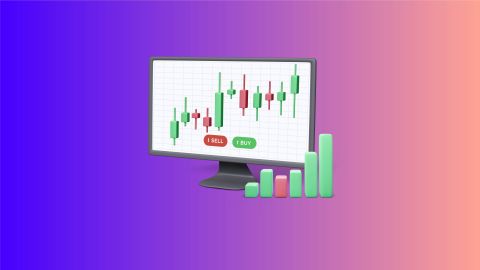Momentum indicator formula
More often than not, you are not required to calculate momentum manually. It can be done using investing websites, portals, and software. However, it is vital to know about the calculation procedure and its various components to be on top of the momentum and trend insights.
For measuring momentum indicators, you can adhere to the following steps:
- The first step involves dividing the present market closing price by a previous period’s price
- You can multiply the resulting number by 100
The formula for momentum indicators is:
Momentum indicator = (Present closing price)/(A previous period's price) × 100
How does momentum indicator work?
The momentum indicator compares a stock’s current closing price to that of a previous period, plotted as a broken line on a chart. Traders interpret highs and lows from this line to assess market strength. A line above zero suggests an uptrend, while below zero implies a downtrend. Divergences between price action and momentum readings—such as higher highs in price but lower highs in momentum—can signal trend exhaustion or reversal, indicating that a shift or correction in the current trend may follow.
Types of momentum indicators
Various momentum indicators exist based on data type and representation, often aiding short-term traders in building effective strategies.
1. Moving Averages (MAs)
Moving averages eliminate wrinkles in the price data over time. The Simple Moving Average (SMA) gives equal weightage to all past price data, while the Exponential Moving Average (EMA) prioritises recent price changes. Moving averages can act as momentum indicators if you compare the current price with the MA line. If the current price is above the SMA and if the EMA is increasing, the momentum may be high (and vice versa).
2. Relative Strength Index (RSI)
The RSI is another reliable momentum indicator that measures how quickly and how much the price of a stock or security has changed recently. It has a value of 0 to 100, with values below 30, meaning the asset is oversold, and values above 70, meaning the asset is overbought. You can use the RSI to gauge momentum by checking its direction. An upward RSI trend suggests increasing momentum and indicates potential buying opportunities (and vice versa).
3. Moving Average Convergence Divergence (MACD)
The MACD is another strong momentum indicator that compares two EMAs — generally the 26-period and 12-period metrics. You can use the MACD to identify periods when the upward or downward trend has a high momentum and plan your trades according. If the MACD line (which measures the difference between the two EMAs) moves away from the signal line (which is the MACD line’s 9-period EMA), the momentum is high (and vice versa).
4. Bollinger bands
Bollinger bands are also momentum indicators that can help you identify how strong or weak the market trend is. The bands plot the SMA of a stock or security and the positive and negative standard deviations from the SMA. A widening of the bands indicates increased market volatility and potentially more momentum. Conversely, when the bands shrink, the momentum may be decreasing.
5. Average Directional Index (ADX)
The ADX measures trend strength and is a key momentum indicator. It includes +DI and -DI lines, indicating bullish or bearish trends. A higher ADX value suggests a stronger trend, helping traders decide whether to go long or short based on directional strength.
6. Rate of Change (ROC)
ROC is a momentum oscillator that compares current and past prices, oscillating above or below zero. Rising ROC values indicate increasing price momentum, while falling values suggest declining momentum. It helps identify price surges or drops effectively.
7. Stochastic Oscillator
This tool compares a security’s closing price to its price range over a specific period. It measures market momentum and speed but not volume. Commonly used to forecast reversals, it helps traders identify overbought or oversold conditions with good timing accuracy.
How to use momentum indicators?
Momentum indicators typically oscillate around a baseline (often 100) and should be used alongside trend analysis to confirm market direction.
1. Momentum trading
In this strategy, you take a long position in securities that are bullish and a short position in those that are bearish. You can use momentum indicators to identify how strong or weak a trend is before deciding whether or not to use it to initiate a trade. It is advisable to capitalise on a strong trend and ignore the weak ones.
2. False breakout
A false breakout occurs when the price seemingly breaks out of a prevailing resistance level, only to reverse again. This occurs because the momentum is insufficient to drive the price upward continuously. You can use momentum indicators in your strategy to identify periods of inadequate momentum and plan your trades accordingly.
3. Flat top breakout
A flat top breakout is a classic momentum indicator-led strategy. The flat top in this case refers to a strong resistance level that the price cannot breach for several trading sessions. However, the bullish volume continues to build. So, if the price manages to break out, the accompanying momentum may be high enough to sustain the upward trend.
4. Bull or bear flag
A flag pattern represents a period of consolidation during a strong uptrend or downtrend. By using momentum indicators, you can confirm the formation of a flag pattern if the momentum temporarily dips. This can help you plan your entry when the price breaks out of the consolidation channel.
Advantages of momentum indicators
With a clear understanding of their purpose and calculation, the benefits of momentum indicators become evident. These tools track price changes over time and evaluate trend strength. They are valuable for traders, offering direct insights that support informed and timely investment decisions.
It is key to remember that momentum indicators do not consider the direction of price movements. For this reason, it is recommended to use these metrics along with other technical analysis indicators like candlestick chart patterns.
Limitations of momentum indicators
Even with numerous benefits and high reliability, momentum indicators do have some drawbacks, which are discussed below:
- Momentum indicators do not have fixed limits. Thus, overbought and oversold levels must be set individually for each stock.
- Extreme prices (too high/too low) in the indicator’s starting window can distort the indicator.
- Indicator movements are often unpredictable and inconsistent.
Thus, even though momentum indicators are useful and important in the financial market, they must be used alongside other indicators to reliably and confidently identify trends and trend reversals.
Conclusion
These momentum indicators can be instrumental in how you create and execute your trading strategies in a trending market. You can scale these metrics across different timeframes to finetune your strategy as needed. For instance, if you want to close your trades within the same session, you can use these metrics as intraday trading indicators along with candlestick charts. This will help you make informed decisions about when to enter or exit the market.





